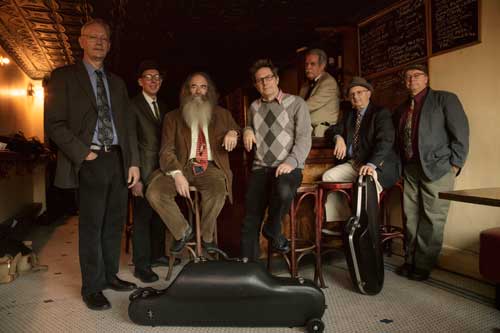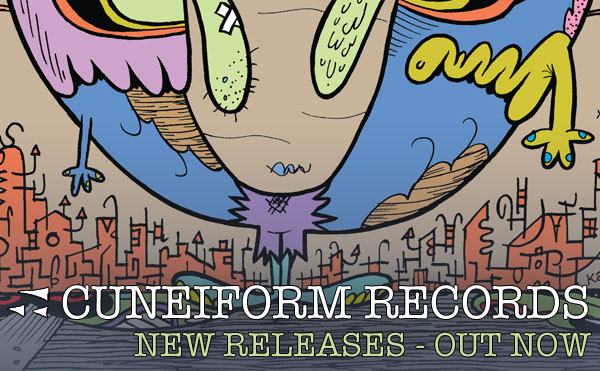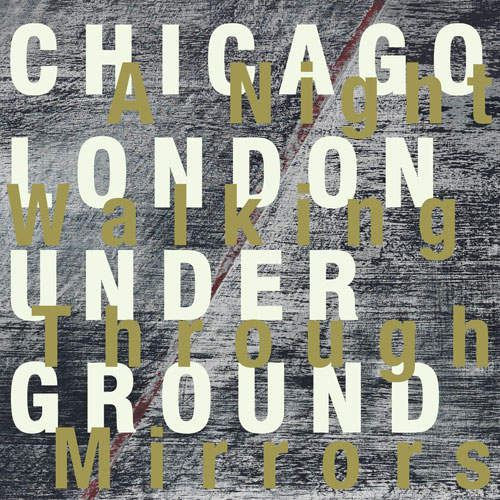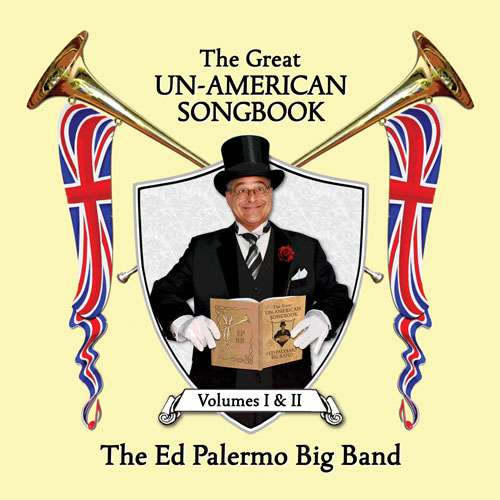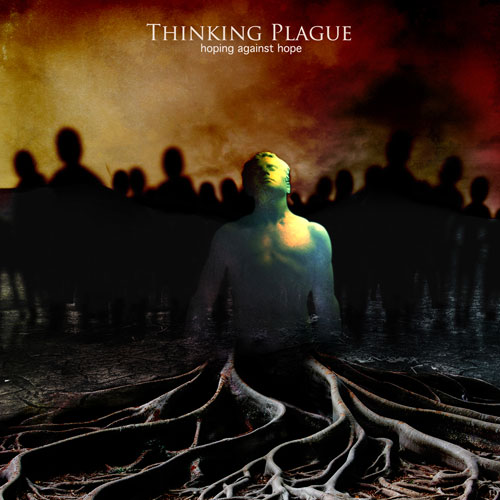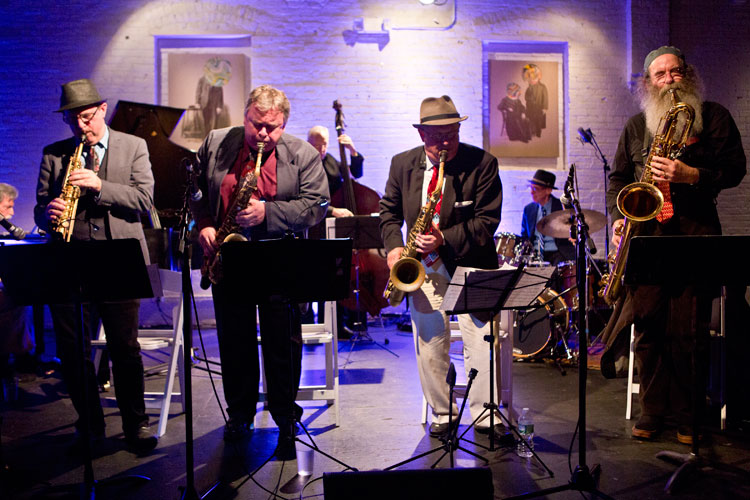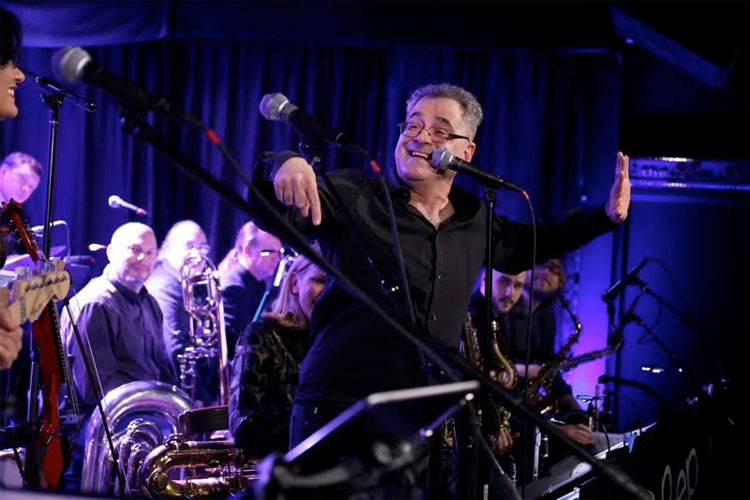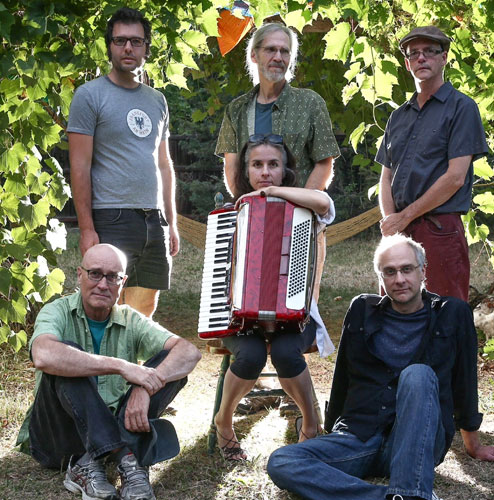Putting the Blues in the News:
The Microscopic Septet takes the Blues
Uptown, Downtown, and All Around on
Been Up So Long It Looks Like Down to Me:
The Micros Play the Blues
The Microscopic Septet
Been Up So Long It Looks Like Down to Me:
The Micros Play the Blues
 STREAM/SHARE: "Don’t Mind If I Do"
stream: @ SoundCloud / @ Bandcamp / @ YouTube
Cat. #: Rune 425, Format: CD / Digital Download
Genre: Jazz
Release Date: February 10, 2017
What happens when you put the blues under a microscope? When the lens is wielded by the incisive deconstructivists of the Microscopic Septet, the musical odyssey traverses territory that’s disarmingly strange, pleasingly familiar and consistently revelatory. It takes an unusual band to make news out of the blues, and the Micros deliver a gripping investigation of the form on Been Up So Long It Looks Like Down to Me: The Micros Play the Blues.
The new album continues the Micros’ brilliant resurgence, storming back into action in 2006 after a 14-year hiatus to reissue its old and release new recordings on Cuneiform Records. Since then, the radically old-school new-context combo has continued to evolve, extending its reputation as one of New York’s most ardently inventive ensembles of the 1980s to being recognized as one of the 21 st Century’s most accomplished, informed, and iconoclastic jazz groups. Throughout, they maintained their distinctive modus operandi: exploring and unraveling jazz’s myriad strains, the Micros re-weave a century of jazz into modern tunes of equal popular and critical appeal. Since 2006, they’ve collaborated with known cartoonists and/or illustrators for their album art, including Art Spiegelman, New Yorker cover artist Barry Blitt, Australian graphic artists Antonia Pesenti and Keith Lobue. The Micros Play the Blues builds on the band’s longstanding love of that most basic and profound musical form, bringing the same reverently irreverent and insistently playful approach to the blues that has marked the Micros’ music from the beginning. This album’s cover art is by Kaz, best known for his comic Underworld and his writing for SpongeBob SquarePants.
“We’ve always loved the blues,” says soprano saxophonist/composer Phillip Johnston, who co-founded the Micros with pianist/composer Joel Forrester. “We’ve recorded blues on every record we’ve made. I don’t think there’s anything more sophisticated than the blues. Our only fear was that the tunes would sound too much alike, and we made a conscious effort to cast a wide net. Every tune sounds different.”
Along with the co-founders, the seven-piece ensemble features largely the same cast of improvisers with which it emerged from Manhattan’s wild and wooly Downtown scene in 1980. Drummer Richard Dworkin, baritone saxophonist David Sewelson, bassist David Hofstra, and altoist Don Davis (who replaced John Zorn in 1981) have all been along for almost the entire Microscopic sojourn, while Mike Hashim came on board for the 2006 reboot, taking over the tenor sax chair from Paul Shapiro (the only Micros spot that’s seen real turnover).
As on previous projects, Johnston and Forrester provide the lion’s share of tunes and arrangements, and they both dig deep into their voluminous catalogs for interesting material. The album opens with Johnston’s late-night cinematic joy ride “Cat Toys,” a piece inspired by Hammond B-3-driven soul jazz and originally written for the credit sequence of a short film about a San Fernando Valley-dwelling space alien with a taste for felines (seriously).
Johnston’s cascading 14-bar “Blues Cubistico” features some brawny baritone sax work by Dave Sewelson, while his cheerful soprano sax intro on “Don’t Mind If I Do” sounds like a rent party picking up steam around 11 pm on a Saturday night. Johnston repurposed “When It’s Getting Dark” from his rock band The Public Servants (which featured guitarist Bill Horvitz, vocalist Shelley Hirsch, and several Micros), and the tune retains its predatory rock ‘n’ rhythm vibe.
“12 Angry Birds” delivers a triumphant verdict on the enduring power of Ellingtonian cadences, as the piece sounds like a forgotten number from the 1927 session on Victor, complete with a deliciously squally soprano sax solo. Long time Micros fans will be delighted to hear tunes that have been in the repertoire for decades but never recorded, like “I’ve Got a Right to Cry.” While not actually a blues, the piece was a 1950 hit for the great Los Angeles R&B band Joe Liggins and the Honeydrippers.
“That’s a tune we did from the very beginning,” Johnston says. “We’ve always played tunes by other people, but didn’t record a lot of them. We have a number of vocal tunes, and we never recorded any of those and I love Dave’s singing on this. ‘I’ve Got a Right to Cry’ isn’t a blues, but it fit in so well with the rest of the album.”
Forrester contributes about half of the album’s tunes, including the sensually slow drag “Dark Blue,” a feature for bassist David Hofstra (who’s walking figure guides the band even when he sits out). The pianist offers a propulsive jazz march with “Migraine Blues,” and designs a deliciously woozy and off-kilter jaunt with “Simple-Minded Blues.” In another utterly surprisingly but entirely sensible move, Forrester turns the carol “Silent Night” into a convincing blues that captures the angst too many people feel as the holidays approach. In fact, Forrester staked a claim to the song at a Christmas party where he “took it into my head to derange Silent Night, which has always struck me as close to the blues,” he says. “During the improvisation the chords were really stripped down. I wanted people to take a more primal approach.”
Whatever the music’s origin or vintage, the Micros put their indelible stamp on each piece, with loose and limber arrangements combining stellar craftsmanship and extroverted improvisation. The blues provide another avenue for the band to explore jazz history while forging a sound quite unlike any other ensemble.
Simultaneously embracing the past and the future makes perfect sense when you consider the fraught time and place that gave birth to the Microscopic Septet. In the early 1980s the New York jazz scene was bitterly divided. Irony-laced Downtown players explored new territory drawing on free jazz, rock, funk and later, Balkan influences. At the same time, other young players, following in the footsteps of trumpeter Wynton Marsalis, defined mainstream jazz by looking backwards to 1950s hard bop and 1960s post bop. Rejecting allegiance to any particular camp or faction, the Micros forged their own path with an ethos succinctly summed up by Johnston: “Break all the rules and respect all the saints.”
Embracing jazz’s populist legacy, the Micros brought Uptown jazz back Downtown, where they made a compelling case that swing could look forward as well as backward. The band adopted a name that playfully alluded to its orchestral palette. As Johnston explained at the time, “The instrumentation is enough to give us a big range of colors and work compositionally in a more expansive way.” But the name also described their compositions, which often distilled the essence of an era within an artfully executed voicing. “Through its command of idiomatic detail,” opined The New York Times, “the group summons the sound of an Ellington orchestra, or the feel of a 50’s rhythm-and-blues band, with a few well-chosen phrases and sonorities.”
The band was built upon the felicitous partnership of Johnston and Forrester, who met in the early 70s and bonded over shared musical aesthetics, humor, and similarly skewed worldviews. Eager to break away from the jazz straightjacket of head-solo-head formats, they honed extended, lapidary jazz compositions that segued gracefully between different themes in a single piece, hearkening forward to forms employed by Sun Ra, Duke Ellington and Jelly Roll Morton. The music drew on the entire history of jazz, as well as polkas, tangos, antic cartoon themes, klezmer, and new wave rock. No matter how eclectic their influences, the Micros always hewed to the band’s prime directive. “It’s gotta swing, whether its Latin or R&B or straight-ahead blowing,” Johnston says. “That’s the foundation of what we do.”
Prolific composers, Forrester and Johnston had created a songbook of nearly 200 tunes by the time the band called it a day in 1992. During the Micros’ first incarnation they only got around to recording 34 pieces on four albums, which were all released on small labels to an impressive array of critical acclaim. The band’s 1983 debut LP, Take the Z Train, came out on Press Records and featured cover art by San Francisco artist Bill Paradise. “It is as if the entire history of improvisatory music is on parade,” Cadence exclaimed. A live album, Let’s Flip!, followed in 1985, recorded in Rotterdam and released by Dutch label Osmosis Records, which also released 1986’s Off Beat Glory. Stash put out Beauty Based on Science in 1988 with liner notes by “New York School” poet, Ron Padgett, cover art by painter Bob Tuska, and cartoons by Collin Kellogg.
In keeping with the band’s perverse ways, they were reaching a vast new audience when they disbanded. Forrester’s theme song for the long-running NPR show Fresh Air with Terry Gross, which continues to be heard by millions of public radio listeners every day, was introduced in 1990. Cuneiform’s decision to reissue the band’s albums on two double albums in 2006, Seven Men in Neckties and Surrealistic Swing, introduced the band to a generation of jazz fans who came of age in the ensuing years. Featuring striking CD artwork by Pulitzer Prize-winning New York cartoonist Art Spiegelman, (creator of the graphic novel Maus), the History of the Micros albums contain all the music from the four original albums and 11 previously unreleased tracks.
The reception was so positive that the band reunited for a European tour, which led to the Micros returning to the studio for 2008’s Lobster Leaps In, an acclaimed Cuneiform album featuring beloved tunes and overlooked gems from the band’s original book. They followed up two years later with the masterful Monk album Friday the Thirteenth: The Micros Play Monk, illustrated with Barry Blitt’s artwork, and made another major leap back into the future with 2014’s acclaimed Manhattan Moonrise, an album that shows the Micros are still a cutting-edge ensemble forging boldly into old territory. “Neither Phillip nor I want to settle into any definite harmonic groove,” Forrester says “Coming up with an array of the blues is just a means taking the Micros into the next century.”
PROMOTIONAL TRACK //
If you'd like to share music from this release, please feel free to use the following track:
 "Don’t Mind If I Do" "Don’t Mind If I Do" stream: @ SoundCloud / @ Bandcamp / @ YouTube
PURCHASE LINKS //
ITUNES - AMAZON - BANDCAMP - WAYSIDE MUSIC
ARTIST WEB SITES //
www.microscopicseptet.com - www.facebook.com/MicroscopicSeptet - www.cuneiformrecords.com
// THE MICROSCOPIC SEPTET - TOUR DATES: 2017 //
| April 2 |
USA |
Small's Jazz Club
183 West 10th St
NYC, NY 10014
|
Album Release Party! |
| April 6 |
USA |
The Falcon
1348 Route 9W
Marlboro, NY 12542 |
Album Release Party! |
-----
The Ed Palermo Big Band is Making America Un-Great Again with a Brilliant Blast of Anglophilia, transforming British Rock Treasures into Wildly Inventive Jazz Vehicles on the Double Album:
The Great Un-American Songbook Volumes I & II
From the Beatles, Rolling Stones and Jeff Beck to King Crimson, Traffic, and Jethro Tull, Palermo’s 18-piece ensemble Storms the British Invasion and Plants the American Flag (upside down)
The Ed Palermo Big Band
The Great Un-American Songbook: Volumes I & II
 STREAM/SHARE: "The Low Spark of High Heeled Boys (Traffic)"
stream: @ SoundCloud / @ Bandcamp / @ YouTube
Cat. #: Rune 435/436, Format: 2xCD / Digital Download
Genre: Jazz / Big Band Jazz
Release Date: February 24, 2017
Crazy times call for outrageous music, and few jazz ensembles are better prepared to meet the surreality of this reality-TV-era than the antic and epically creative Ed Palermo Big Band. The New Jersey saxophonist, composer and arranger is best known for his celebrated performances interpreting the ingenious compositions of Frank Zappa, an extensive body of work documented on previous Cuneiform albums such as 2006’s Take Your Clothes Off When You Dance and 2009’s Eddy Loves Frank.
His fifth project for the label, The Great Un-American Songbook Volumes 1 & 2 is a love letter to the rockers who ruled the AM and FM airwaves in the 1960s via successive waves of the British Invasion. Featuring largely the same stellar cast of players as last year’s gloriously eclectic One Child Left Behind, the 18-piece EPBB lovingly reinvents songs famous and obscure, leaving them readily recognizable and utterly transformed. The first installments in what he hopes to be an ongoing project (he is currently working on an Un-American Songbook, Volume 3), these two volumes give a whole new meaning to Swinging London.
Volume 1 kicks off with guitarist/vocalist Bruce McDaniel belting Lennon and McCartney’s “Good Morning, Good Morning” (Palermo obsessives will notice that the track opens with a bleating goat, which is rumored to be the same creature heard at the end of One Child Left Behind…how’s that for continuity?) The Beatles provide the widest thread running through the project, including an instrumental version of “Eleanor Rigby” that’s a tour de force by violinist Katie Jacoby (who also tears up King Crimson’s prog rock masterpiece “Larks’ Tongue in Aspic, Part 2”).
Palermo deploys his surging horns on an ecstatically sanguinary romp through Blodwyn Pig’s “Send Your Son to Die,” and delivers another blast of brass on the extended arrangement of Nicky Hopkins’ “Edward, The Mad Shirt Grinder,” a piece introduced on Quicksilver Messenger Service’s album Shady Grove. A pedant might quibble that a recording by a San Francisco band doesn’t belong in The Great Un-American Songbook, but was there a more British Brit than Hopkins, the era’s definitive session keyboardist? Anyway, the picaresque piece provides the players with a consistently inspiring vehicle for improvising, including Ben Kono’s torrid tenor, John Bailey’s thoughtful and beautifully calibrated trumpet, and another arresting violin solo by Jacoby.
More than any other EPBB release, The Great Un-American Songbook is like rummaging around Palermo’s record collection and playing tracks at random after imbibing an espresso-laced bottle of absinth. He’s the first to admit that the album is a highly personal and nostalgia-induced undertaking. “Almost everything I do lately is reliving my past,” Palermo says. “With the craft and skill I’ve developed being an arranger for all these years, I can now take those songs that I grew up with and loved, and reinterpret them. I picked my favorite songs, songs that I’m going to want to hear and play a lot. There’s really no other way to explain my selection process.”
Volume 2 opens with another rule-breaking wild card, as Palermo mashes up the Berkeley punk band Green Day’s bitter indictment “American Idiot” with the point-counterpoint exchange of the West Side Story anthem “America.” In his completely unnecessary defense, Palermo points out that he’s inspired by the version of “America” that Keith Emerson recorded with his pre- ELP band The Nice, rather than the Broadway cast album or film soundtrack. Jethro Tull’s “Beggar’s Farm” features an appropriately charged Ben Kono flute solo, while also unleashing Bruce McDaniel’s vocals, which register just the right tone of reverent irreverence (or is that irreverent reverence?). There are far too many highlights to mention them all, but Napoleon Murphy Brock’s vocals on The Crazy World of Arthur Brown’s “Fire” sounds like a lost Zappa outtake (Zappologists will catch numerous Zappa quotes and references laced throughout the project).
Speaking of irreverence, Palermo populates the Songbook with a vivid cast of characters providing some running commentary, including his fey executive producer, Edvard Loog Wanker III, Pete Best, and Ringo Starr’s long-lost cousin, Mick Starkey, who ends the album with a brief blast of Beatlemania on “I Want to Be Your Man” and “Good Night.” But don’t miss the hilariously majestic hidden track featuring the cranky but always-game crooner Mike James (last heard pondering the meaning of it all on One Child’s “Is That All There Is?”). By the end of the long and winding road through Palermo’s musical backpages there’s no doubt that his nostalgia is our delight, as vintage rock songs make for state-of-the-art jazz.
“Anything can be grist for the mill,” Palermo says. “Once I start an arrangement I get so into it. I’m going to put my spin on it.”
In many ways, Palermo’s career is a case study in getting the last laugh. Born in Ocean City, New Jersey on June 14, 1954, he grew up in the cultural orbit of Philadelphia, which was about an hour drive away. He started playing clarinet in elementary school, and soon turned to the alto saxophone. He also took up the guitar, and credits his teenage obsession with Zappa to opening his ears to post-bop harmonies and improvisation.
Palermo caught the jazz bug while attending DePaul University, and took to the alto sax with renewed diligence inspired by Phil Woods, Cannonball Adderley, and Edgar Winter (the subject of an upcoming EPBB project). Before he graduated he was leading his own band and making a good living as a studio player recording commercial jingles. But like so many jazz musicians he answered New York’s siren call, moving to Manhattan in 1977. After a year of playing jam sessions and scuffling, Palermo landed a coveted gig with Tito Puente, a four-year stint that immersed him in Afro-Cuban music.
An encounter with trumpeter Woody Shaw’s septet at the Village Vanguard in the late 1970s stoked his interest in writing and arranging for multiple horns, and by the end of the decade he had launched a nine-piece rehearsal band with five horns. Between Don Sebesky’s well-regarded book The Contemporary Arranger and advice from Dave Lalama and Tim Ouimette “I got a lot of my questions answered and I’ll love them forever,” Palermo says. “Then the real education was trial and error. I lived in a little apartment with no TV or furniture. All I had was a card table, and once a week I’d rehearse my nonet, then listen to the cassette of the rehearsal and make all the changes.”
Palermo made his recording debut in 1982, an impressive session featuring heavyweights such as David Sanborn, Edgar Winter and Randy Brecker. As a consummate studio cat and sideman, he toured and recorded with an array of stars, including Aretha Franklin, Eddie Palmieri, Celia Cruz, Lena Horne, Tony Bennett, Mel Tormé, Lou Rawls, Melba Moore, The Spinners, and many others. As an arranger, he’s written charts for the Tonight Show Band, Maurice Hines, Eddy Fischer, and Melissa Walker. Employed frequently by bass star Christian McBride for a disparate array of projects, Palermo has written arrangements for a James Brown concert at the Hollywood Bowl, a Frank Sinatra tribute featuring Kurt Elling, Seth McFarland, John Pizzarelli, and a 20-minute medley of Wayne Shorter tunes for the New Jersey Ballet.
Palermo had been leading his big band for more than a decade before the Zappa concept started coming together. Inspired by electric guitar master Mike Keneally, who performed with Zappa on some of his final concerts before his death in 1993, Palermo decided to arrange a program of 12 Zappa tunes. When the time came to debut the material at one of the band’s regular gigs at the Bitter End in early 1994, a sold-out crowd greeted the band. “The Internet was just becoming powerful, and word really got around,” Palermo says. “We were used to playing for small audiences, and the place was packed. There were people who had driven down from Canada, and up from West Virginia who didn’t have a clue who I was, but they wanted to hear Zappa’s music. It was an amazing night.”
The Ed Palermo Big Band earned international attention with its 1997 debut The Ed Palermo Big Band Plays Frank Zappa on Astor Place Records. With Palermo’s brilliant arrangements and soloists such as Bob Mintzer, Chris Potter, Dave Samuels, Mike Stern, and Mike Keneally, the album made an undisputable case for the Zappa jazz concept. His first album of Zappa tunes on Cuneiform Records, called Take Your Clothes Off When You Dance, came out in 2006, followed in 2009 by Eddy Loves Frank. But while Palermo has written more than 300 Zappa charts, he’s anything but a one-trick pony. Recent releases like 2014’s Oh No! Not Jazz!! and 2016’s One Child Left Behind, both on Cuneiform, featured a bountiful selection of his original compositions and material by composers not named Frank Zappa.
Nothing demonstrates the ensemble’s ongoing vitality better than the stellar cast of players, with longtime collaborators such as violinist Katie Jacoby, baritone saxophonist Barbara Cifelli, drummer Ray Marchica, and keyboardist Ted Kooshian. Many of these top-shelf musicians have been in the band for more than a decade, and they bring wide ranging experience, expert musicianship and emotional intensity to Palermo’s music. From the first note, well, after the goat, the band manifests greatness in a truly Un-American cause.
PROMOTIONAL TRACK //
If you'd like to share music from this release, please feel free to use the following track:
 "The Low Spark of High Heeled Boys (Traffic)" "The Low Spark of High Heeled Boys (Traffic)": @ SoundCloud / @ Bandcamp / @ YouTube
PURCHASE LINKS //
ITUNES - AMAZON - BANDCAMP - WAYSIDE MUSIC
ARTIST WEB SITES //
www.palermobigband.com - www.cuneiformrecords.com
// THE ED PALERMO BIG BAND - TOUR DATES: 2017 //
| March 23 |
USA |
Charity Concert
322 West 48th St - NYC, NY |
To Benefit Musician's Emergency Relief Fund |
| April 1 |
USA |
The Falcon
1348 Route 9W
Marlboro, NY 12542 |
[the music of The Beatles!] |
| April 10 |
USA |
The Iridium
1650 Broadway
NYC, NY |
|
| May 8 |
USA |
The Iridium
1650 Broadway
NYC, NY |
|
| June 3 |
USA |
The Falcon
1348 Route 9W
Marlboro, NY 12542 |
|
| June 19 |
USA |
The Iridium
1650 Broadway
NYC, NY |
|
| August 19 |
USA |
The Falcon
1348 Route 9W
Marlboro, NY 12542 |
|
| August 21 |
USA |
The Iridium
1650 Broadway
NYC, NY |
|
| October 28 |
USA |
The Falcon
1348 Route 9W
Marlboro, NY 12542 |
|
| December 23 |
USA |
The Falcon
1348 Route 9W
Marlboro, NY 12542 |
|
|
-----
In Hoping Against Hope, Avant /Art-Rock Band THINKING PLAGUE’s Latest Release, Compositional Savant Mike Johnson Creates
an Extraordinary and Beautiful Polyphonic Response to the
Dark Times We Live In
Thinking Plague
Hoping Against Hope
 STREAM/SHARE: "The Echoes of Their Cries"
stream: @ SoundCloud / @ Bandcamp / @ YouTube
Cat. #: Rune 421, Format: CD / Digital Download
Genre: Rock / Avant-Progressive / Art-Rock / Post-Rock / Post-Classical
Release Date: February 10, 2017
Clouds scud across a storm-wracked sky, sometimes exposing shards of blue, but most often, darker greys lurk behind. Hoping Against Hope is a darkly beautiful and complex album that offers hope against hope, against the hope that things will somehow work out for the best, or that someone will somehow fix it all for us. In a time when hope seems both scarcer and more necessary than ever, Thinking Plague don’t offer the fleeting consolation of a fairy tale, but the enduring and tangible value of an unvarnished and courageous artistic response. By creating art, something of beauty, while amidst winds of despair, Thinking Plague has evolved its own means to survive grim times and marked out a path for us. Recorded music, however good, can’t mend a broken world, but a record as brilliant as Hoping Against Hope offers us artistic refuge, an imaginative space where we can restore body, mind and soul and form our own personal response to a world in crisis.
Thinking Plague is a storied band, whose thirty-five year history has seen it cleave consistently to the extreme limits of what is possible to do within rock music. Much of the music it released has owed more to traditions external to rock, such as folk, chamber music, and particularly, the avant-garde tradition of twentieth-century classical music. Its thread has always been twisted into a thicker yarn, variously labeled with terms such as ‘art rock’, ‘avant-rock’, ‘avant-progressive’ and also ‘ Rock in Opposition’( RIO), a term associated with European outfits such as Henry Cow, Art Bears, Art Zoyd and Present who fused elements and instruments from rock and 20 th century classical music with compositional rigour and DIY aesthetics. Thinking Plague are often cited as the leading light of the American arm of the ‘Rock In Opposition’ movement, closely aligned with the fellow Denver, Colorado ensemble, Hamster Theatre, with which they share personnel. Genre-defying and, above all, unique, Thinking Plague’s music can be described equally as post-rock and/or post-classical.
Founded in 1982 by Mike Johnson and the legendary Bob Drake, they have been a continuous presence in the underground since then, although many years have elapsed between recordings, and only Johnson remains from the original line-up. Their third album, 1989’s In This Life, was released on Chris Cutler’s London-based ReR label and widely distributed, and the band enjoyed global attention in avant-rock circles. By 1990 Drake was working as a recording engineer in Los Angeles, and singer Susanne Lewis was in New York City, pursuing her own musical vision. It was nearly ten years before their critically acclaimed fourth album, In Extremis (1998), was released with a new line-up, inaugurating Thinking Plague’s ongoing relationship with Cuneiform Records. Cuneiform released a further two studio albums - A History of Madness (2003) and Decline and Fall (2012)- and a compilation of their early studio recordings, called Early Plague Years (2000), and in 2015 reissued In This Life.
Leader and writer Johnson is influenced by harmonically adventurous twentieth-century classical music, as can be heard in the ambiguous tonality of the music, and the rigour of his dense, complex compositions. Johnson, like most rock musicians, is self-taught, but very knowledgeable, and his fusion of rock, folk and classical music is as seamless as it is compelling. The electric guitar, whose hard-edged, mordant timbres cut deeper and more savagely than anything available to the classical arranger, doesn’t dominate the band’s sound, but takes its place as one voice among many, while the drum kit is exploited with subtlety.
The arrangements we hear on Hoping Against Hope, as on Decline and Fall (the previous album), are those we will hear live. Even when singer Elaine di Falco’s accordion is written and recorded in multiple voices, the parts are realizable by a single instrument. Conversely, Johnson and Bill Pohl’s tightly scored twin guitars are panned out wide enough for the listener tobalance the pursuit of an individual voice against the ensemble texture, which is the creative focus, a carefully crafted polyphony served by each
instrumental voice. There is a familiar vocabulary in play, a harmonic palette and a phraseology that has evolved considerably over the band’s lifespan without extreme points of rupture, despite major changes and sometimes long gaps between releases; this is clearly the same band that we heard in the 1980s, but Johnson is writing from a creative position that is fruitfully removed from that he occupied even four years ago.
Completing the core line-up for this album are long-term members Mark Harris (reeds) and Dave Willey (bass), as well as more recent recruit Robin Chestnut (drums). Pohl’s addition brings a second electric guitar to the texture for the first time, enabling more sinuous scoring, rather than making the sound more ‘rock’. Although other musicians contribute parts, there’s a strong sense of continuity, revealing a well-drilled ensemble performing a coherent body of work. As demanding as this music may be, it is made to sound easy, and more importantly, beautiful.
Dark times globally made it hard to produce an optimistic album, but this record is still a constructive critique, rather than a lament or a turning away. With its mention of externalities, ‘Commuting to Murder’ highlights the ideological congruity of militarism and capitalist economics, while ‘A Dirge for the Unwitting’ notes, and declines to condemn, the disaffection that impels some towards the death-drive of religious fundamentalism. ‘The Echoes of Their Cries’ and ‘The Great Leap Backwards’ seem overwhelmed by the horrors of military intervention and ‘post-truth’ culture (respectively), to the extent that they eschew image or allusion; but ‘Hoping Against Hope’ asserts the endurance of the critical observer, however isolated or disheartened, and vests its faith in the persistence of a marginalized wisdom.
In support of such lyrical texts, and in their own right, Johnson’s compositions are committed to emotional truth in all its complexity, rather than dictating to the listener what they should feel about the topics of the songs. And although this is not a ‘feel-good’ album, its hopeful inclination is reflected in a less abstract approach than on previous records. There are extended sections in regular meters, and periods of stable tonality offer the listener a continuity to grasp that is perhaps analogous to the experience of the narrator in ‘Hoping Against Hope’.
Despite the complexity of its music, Thinking Plague is an astoundingly impressive live band. It has played worldwide at avant-garde and progressive music festivals, and toured in the US and Europe. The complex arrangements featured on this album are written for live performance, where the passionate commitment and instrumental precision that the works demand can be witnessed in their full fury. Most recently, Thinking Plague toured Texas, performing in Dallas’ Kessler Theater, Austin’s Salvage Vanguard, and other cities, and played numerous shows in Colorado, at Boulder’s Dairy Center for the Performing Arts and other venues. They’ve performed at such international festivals as Rock in Opposition and Les Tritonales in France, Gouveia Art Rock Festival in Portugal, and Nearfest, Cuneifest, ProgDay, Seattle’s Seaprog, and The Olympia Experimental Music Festival in the USA The demanding, rehearsal intensive nature of their material makes their recordings infrequent, and opportunities to hear this important band scarce: performances are often made to capacity crowds as a result. Thinking Plague is looking forward to touring the US East Coast in 2017, and performing at festivals in the US and abroad.
Sometimes a work of art enables us to articulate our thoughts and feelings in times of upheaval and chaos. In an era when the world has seemingly come off its hinges, an album like Hoping Against Hope offers listeners the consolation that they are not alone. But more than that, this intellectually complex work offers tools to help us make sense, affectively at least, of the whole sorry mess. Knowledge, as the philosopher Michel Foucault said, is not for understanding: knowledge is for cutting. And in Hoping Against Hope, Thinking Plague supplies its listeners with a finely honed scalpel.
PROMOTIONAL TRACK //
If you'd like to share music from this release with your readers/listeners, please feel free to use the following track:
 "The Echoes of Their Cries" "The Echoes of Their Cries": @ SoundCloud / @ Bandcamp / @ YouTube
PURCHASE LINKS //
ITUNES - AMAZON - BANDCAMP - WAYSIDE MUSIC
ARTIST WEB SITES //
www.thinkingplague.org - www.cuneiformrecords.com
Thinking Plague @ Facebook |
|
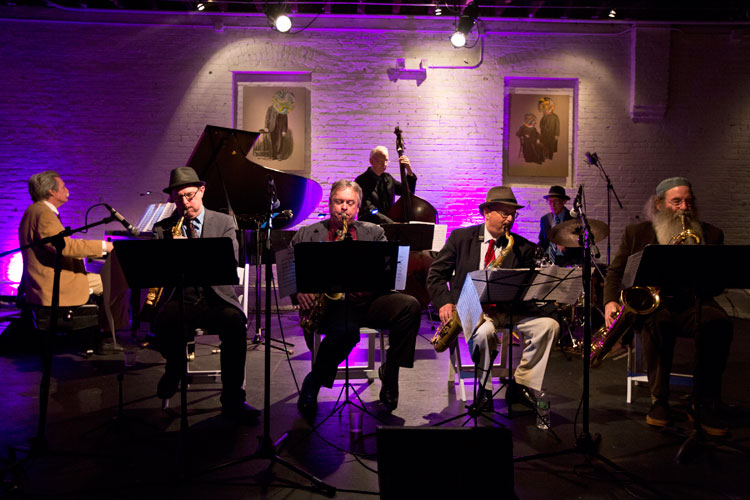
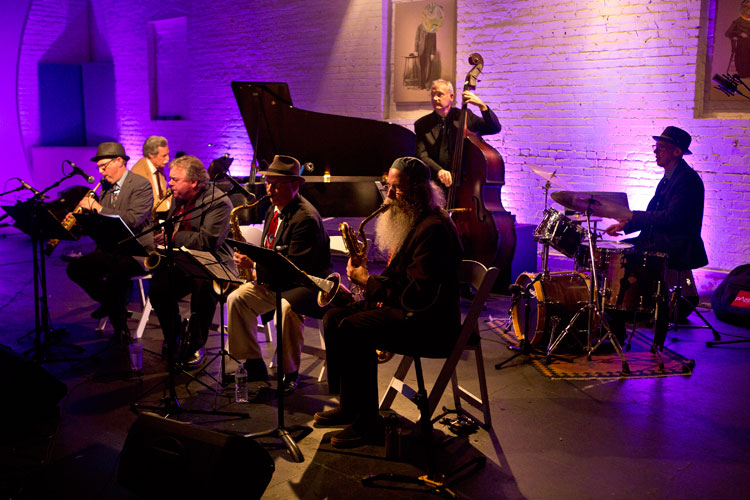
 "Don’t Mind If I Do" stream: @SoundCloud / @Bandcamp / @YouTube
"Don’t Mind If I Do" stream: @SoundCloud / @Bandcamp / @YouTube
